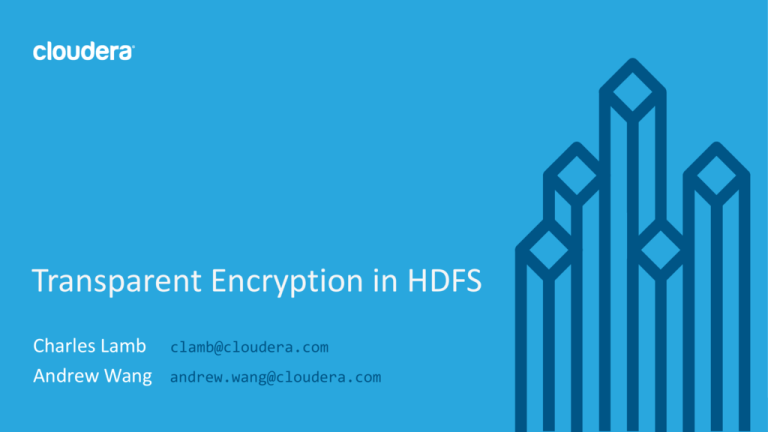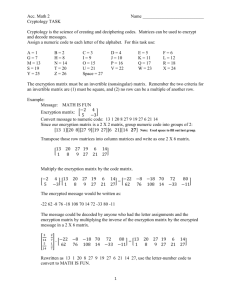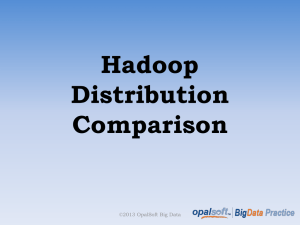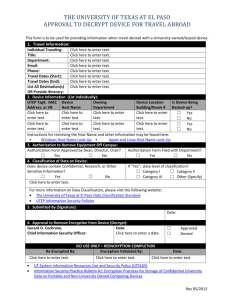
Transparent Encryption in HDFS
Charles Lamb
Andrew Wang
clamb@cloudera.com
andrew.wang@cloudera.com
© Cloudera, Inc. All rights reserved.
1
Why do we need
encryption?
© Cloudera, Inc. All rights reserved.
2
© Cloudera, Inc. All rights reserved.
3
Importance of Encryption
Information leaks affect 10s to 100s of millions of people
• Personally identifiable information (PII)
• Credit cards, SSNs, account logins
• Encryption would have prevented some of these leaks
• Encryption is a regulatory requirement for many business sectors
• Finance (PCI DSS)
• Government (Data Protection Directive)
• Healthcare (DPD, HIPAA)
•
© Cloudera, Inc. All rights reserved.
4
Access to Sensitive Information
Only as secure as the weakest link
• Need to carefully control access to:
• Encryption keys
• Encrypted ciphertext
• Keys and ciphertext together (and thus plaintext!)
•
•
Many potential attack vectors
© Cloudera, Inc. All rights reserved.
5
© Cloudera, Inc. All rights reserved.
7
Attack Vectors
Physical access
• Data at-rest on hard drives
• Network sniffing
• Data in-transit on the network
• Rogue user or admin
• Insider access to encrypted data, encryption keys
• Particularly difficult for admins
•
© Cloudera, Inc. All rights reserved.
9
Why Encrypt in HDFS?
HDFS
Local Disk
Flexibility
Database
Simplicity
Application
© Cloudera, Inc. All rights reserved.
10
Why Encrypt in HDFS?
Application
Database
HDFS
HDFS is a sweet spot
• Excellent performance
• Safe from OS attacks
• App transparency
• Easy to deploy
Local Disk
© Cloudera, Inc. All rights reserved.
11
Architecture
Client
KMS
KS
Key Management
Server
Backing
Key Server
NN
NameNode
DN
DataNode
© Cloudera, Inc. All rights reserved.
12
Architecture
Client
KMS
KT
Key Management
Server
Cloudera
Navigator
KeyTrustee
NN
NameNode
DN
DataNode
© Cloudera, Inc. All rights reserved.
13
Architecture
Per-file key
operations
Client
Read/write
encrypted data
KMS
KT
NN
DN
© Cloudera, Inc. All rights reserved.
14
Architecture
Keys
Client
KMS
NN
Data
KT
Separate
administrative
domains
DN
© Cloudera, Inc. All rights reserved.
15
Design
KMS and key server manage encryption keys
• HDFS never touches encryption keys or plaintext
• End-to-end client-side encryption
• Data is protected both at-rest and in-transit
• Granular per-file encryption keys and per-key ACLs
• Rogue user can only leak their own data
• Separate administrative domains for key management and HDFS
• Rogue admins do not have access to both keys and data
• API transparency for existing applications
• High-performance
•
© Cloudera, Inc. All rights reserved.
16
Architectural Concepts
Encryption zone (EZ)
• Key types: EZ keys, (E)DEKs
• Key Management Server (KMS)
• Key handling during writes and reads
•
© Cloudera, Inc. All rights reserved.
17
Encryption Zones (EZs)
Directory whose contents are encrypted on write and decrypted on read
• Encryption is transparent to applications (simple!)
• No code changes required
• Invariant: files in an EZ are encrypted, files not in an EZ are not encrypted
• Existing files are not encrypted in place
• An EZ begins life as an empty directory
• Renames in to and out of an EZ are prohibited
• Encryption zones cannot be nested
•
© Cloudera, Inc. All rights reserved.
18
Recommended EZ Setup
Single root encryption zone
• Pros: conceptually simple, easy to configure
• Cons: less secure, hard to migrate to multiple EZs
• Separate per-user or per-org encryption zones
• Pros: compartmentalizes security
• Cons: more keys to manage
•
© Cloudera, Inc. All rights reserved.
19
Encryption Zone Key (EZ key)
Unique key per encryption zone
• EZ key metadata is stored in an xattr on the EZ root directory
• EZ key material is stored in the Key Management Server
• NameNode never touches the key
•
© Cloudera, Inc. All rights reserved.
20
(Encrypted) Data Encryption Keys
Data Encryption Key (DEK)
• Unique DEK per file
• Used by client to encrypt and decrypt data in HDFS
• Only handled by client and KMS, never HDFS
• DataNodes never handle plaintext, only ciphertext
• Encrypted Data Encryption Key (EDEK)
• DEK encrypted with corresponding EZ key
• Generated by KMS for NameNode
• Stored in HDFS metadata as a file xattr
•
© Cloudera, Inc. All rights reserved.
21
EZ Keys, DEKs, and EDEKs
© Cloudera, Inc. All rights reserved.
22
EZ Keys, DEKs, and EDEKs
© Cloudera, Inc. All rights reserved.
23
Key Management Server
Caching proxy for an enterprise key server
• Presents a unified key API to cluster services
• Scalable, fault-tolerant, high-performance
• Typically backed by Cloudera Navigator KeyTrustee
• Handles key operations with fine-grained ACLs
• Create and retrieve EZ keys
• Generate and decrypt EDEKs
• Separate secure process
• Separate key administrator
•
© Cloudera, Inc. All rights reserved.
24
Writing an Encrypted File
KMS
Fetch EDEK for /ez/
Client
NN
myFile
create
/ez/myFile
DN
© Cloudera, Inc. All rights reserved.
25
Writing an Encrypted File
KMS
Decrypt EDEK
Fetch EDEK for /ez/
Client
NN
myFile
DN
File data
create
/ez/myFile
Write encrypted
data
© Cloudera, Inc. All rights reserved.
26
Reading an Encrypted File
KMS
Decrypt EDEK
Client
NN
myFile
DN
File data
open
/ez/myFile
Read
encrypted
Decrypt
with DEK
data
© Cloudera, Inc. All rights reserved.
27
Key Handling
•
Writing a file
• Client asks NameNode to create a file in an EZ
• NameNode gets a new EDEK from KMS
• NameNode stores EDEK in file’s xattr and returns EDEK to client
• Client asks KMS to decrypt EDEK
• KMS decrypts EDEK and returns DEK to client
• Client uses DEK to encrypt file data
© Cloudera, Inc. All rights reserved.
28
Key Handling
•
Reading a file
• Client asks NameNode for file’s EDEK
• Client asks KMS to decrypt EDEK
• KMS decrypts EDEK and returns DEK to client
• Client uses DEK to decrypt data
© Cloudera, Inc. All rights reserved.
29
Granular Access Controls
Granular HDFS-level access controls
• Controls access to encrypted ciphertext
• HDFS ACLs and Unix-like permissions
• Granular KMS-level access controls
• Per-EZ key ACLs
• Per-operation ACLs (generate and decrypt EDEKs)
• Whitelist and blacklist
• See our docs
•
© Cloudera, Inc. All rights reserved.
30
Attack Vectors
Compromised EZ key
• Also requires EDEK and ciphertext
• Only leaks a single zone
• Compromised EDEK
• Also requires EZ key and ciphertext
• Only leaks a single file
• Compromised ciphertext
• Also requires corresponding EZ key and EDEK
• Only leaks a single file
•
© Cloudera, Inc. All rights reserved.
31
Quickstart: Create a key and an EZ
$ # as the key administrator user
$ hadoop key create mykey
$
$
$
$
$
# as the HDFS administrator user
hadoop fs –mkdir /users/cwl/my-ez
hadoop fs –chown cwl /users/cwl/my-ez
hadoop fs –chmod 700 /users/cwl/my-ez
hadoop crypto –createZone –keyName mykey \
–path /users/cwl/my-ez
© Cloudera, Inc. All rights reserved.
32
Quickstart: put and get a file into the EZ
$ # as the encryption user
$ echo “hello world” > hello-world.txt
$ hadoop fs –put hello-world.txt /users/cwl/my-ez/
$ hadoop fs –cat /users/cwl/my-ez/hello-world.txt
hello world
$
© Cloudera, Inc. All rights reserved.
33
Quickstart: verify the file is encrypted
$ # as the HDFS admin
$ hadoop fs –cat \
/.reserved/raw/users/cwl/my-ez/hello-world.txt
��嶗]ܙN^���+���
$
© Cloudera, Inc. All rights reserved.
34
Encryption Ciphers
Currently, only AES-CTR is implemented
• 128 or 256 bit keys
• Cipher is designed to be pluggable
• Other ciphers are future work
• AES-GCM would provide authenticated encryption
• Great place for contributions!
•
© Cloudera, Inc. All rights reserved.
35
AES-NI Hardware Acceleration
Joint work with Intel engineers
• Two implementations of AES-CTR
• JCE software implementation
• OpenSSL hardware-accelerated AES-NI implementation
• AES-NI is available in Westmere (2010) and newer Intel CPUs
• AES-NI further optimized in Haswell (2013)
•
© Cloudera, Inc. All rights reserved.
36
Microbenchmark: Encrypt/Decrypt 1GB Byte Array
How much faster is AES-NI accelerated AES-CTR?
• Encrypt and decrypt a 1GB byte array
• Single-threaded
• Run locally on a single Haswell machine
• Excludes HDFS overheads (checksumming, network, copies)
•
© Cloudera, Inc. All rights reserved.
37
Microbenchmark: Encrypt/Decrypt 1GB Byte Array
2500
MB/sec
2000
1500
1000
500
0
Encryption
Decryption
With NI
Without NI
© Cloudera, Inc. All rights reserved.
38
Macrobenchmark: TestDFSIO
What is the overhead of using encryption?
• TestDFSIO
• IO-heavy benchmark
• Reading and writing 300GB files
• Encrypted vs. unencrypted
• Cluster setup
• 3 datanodes, so all reads are local
• 64GB memory, so datasize larger than memory
• OpenSSL enabled, with Haswell AES-NI optimizations
•
© Cloudera, Inc. All rights reserved.
39
MB/sec
Macrobenchmark: TestDFSIO
160
140
120
100
80
60
40
20
0
Read
Non-Encrypted
Write
Encrypted
© Cloudera, Inc. All rights reserved.
40
Performance Takeaways
OpenSSL and AES-NI acceleration is highly recommended
• 16x microbenchmark speedup
• Minor performance impact on HDFS reads and writes
• 7.5% for reads, ~0% for writes
• Most realistic workloads will see little to no impact
• TestDFSIO is extremely IO bound
• Terasort comparisons had no difference in runtime
•
© Cloudera, Inc. All rights reserved.
41
Conclusion
End-to-end, client-side encryption
• Data protected at-rest and in-transit
• Key Management Server and Cloudera Navigator KeyTrustee
• Secure key management, storage, access
• Separate administrative domains for key management and HDFS
• API transparent for existing applications
• Performance transparent
• Marginal overhead with AES-NI hardware acceleration
•
© Cloudera, Inc. All rights reserved.
42
Acknowledgements
Cloudera
• Alejandro Abdelnur
• Aaron T. Myers
• Arun Suresh
• Colin McCabe
• Intel
• Yi Liu
• Haifeng Chen
•
© Cloudera, Inc. All rights reserved.
43
Questions
© Cloudera, Inc. All rights reserved.
44
Key Rotation
Encryption zone keys can be rolled
• Newly generated EDEKs use the new key version
• Currently no support for reencrypting existing EDEKs
• Still encrypted with the old key version
• Doable, but requires a lot of KMS RPCs from NN
• Rolling DEKs is also unsupported
• Requires reencrypting the data, expensive
• One method is to distcp and then delete the old copy
•
© Cloudera, Inc. All rights reserved.
45
DistCp
Encryption Zone to Encryption Zone
• use –update –skipcrccheck
• Admins use special /.reserved/raw path prefix
• /.reserved/raw is only available to root and provides the encrypted
contents
•
© Cloudera, Inc. All rights reserved.
46
KMS Per-User ACL Configuration
White lists (check for inclusion) and black lists (check for exclusion)
• etc/hadoop/kms-acls.xml
• hadoop.kms.acl.CREATE
• hadoop.kms.blacklist.CREATE
• … DELETE, ROLLOVER, GET, GET_KEYS, GET_METADATA,
GENERATE_EEK, DECRYPT_EEK
•
© Cloudera, Inc. All rights reserved.
47
KMS Per-Key ACL Configuration
•
etc/hadoop/kms-acls.xml
• hadoop.kms.acl.<keyname>.<operation>
• MANAGEMENT – createKey, deleteKey, rolloverNewVersion
• GENERATE_EEK – generateEncryptedKey,
warmUpEncryptedKeys
• DECRYPT_EEK – decryptEncryptedKey
• READ – getKeyVersion, getKeyVersions, getMetadata,
getKeysMetadata, getCurrentKey
• ALL – all of the above
© Cloudera, Inc. All rights reserved.
48
Exceptions
•
Hive: may not be able to do a query that combines data from more than one
encryption zone
© Cloudera, Inc. All rights reserved.
49
Sample Icons
© Cloudera, Inc. All rights reserved.
50
Key Management Server (KMS)
KMS sits between client and key server
• E.g. Cloudera Navigator Key Trustee
• Provides a unified API and scalability
• REST API
• Does not actually store keys (backend does that), but does cache them
• ACLs on per-key basis
•
© Cloudera, Inc. All rights reserved.
51
High-profile leaks
•
Many personal information leaks over the years
• Feb 2015, PII of 80 million Anthem customers
• Nov 2014, Sony Pictures Entertainment hack
• Mar 2014, PII of 40 million Target customers
• Apr 2011, 77 million PlayStation Network accounts
• Jan 2009, 100 million HPS credit cards
• Jan 2007, 45 million TJX SSNs and other personal information
© Cloudera, Inc. All rights reserved.
52
© Cloudera, Inc. All rights reserved.
53
© Cloudera, Inc. All rights reserved.
54
© Cloudera, Inc. All rights reserved.
55





